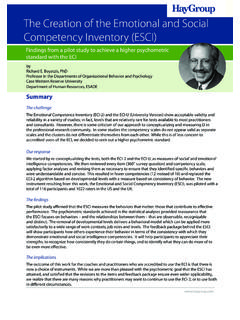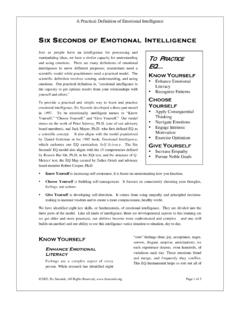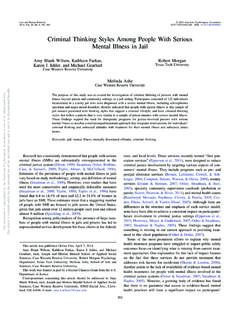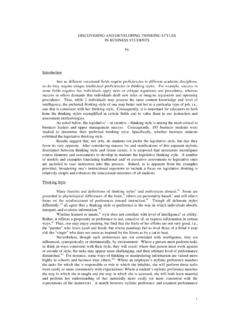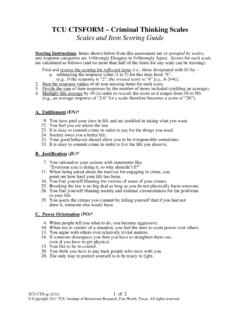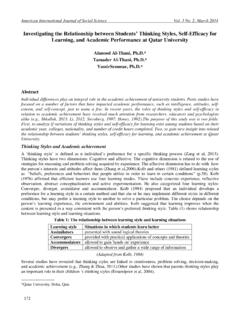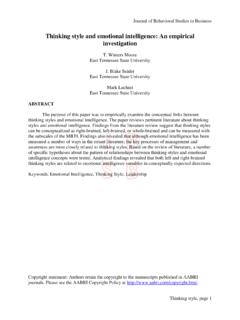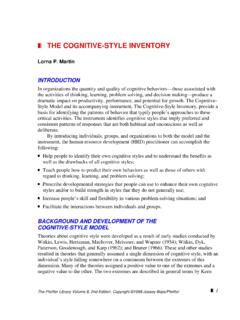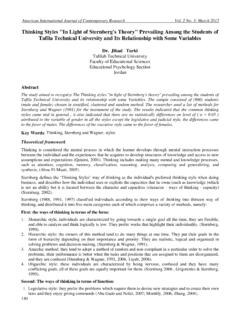Transcription of Handout 11–1 What’s Your Thinking Style? - e-russell.com
1 Handout 11 1 what s your Thinking Style? Some people love to start new projects but run out of steam before they re finished. Otherslove to bring order out of chaos and they enjoy the feeling of completion that comes with ajob well done. Some people love to present new ideas and help people see connections innew ways. Others love to tinker with concepts and gadgets, taking them apart and puttingthem back together of us has our own unique Thinking style. Understanding how we think can help usbuild on our strengths and know when we need to build partnerships with others to fill inour gaps. Having a preferred Thinking style does not mean that we can t use the otherthinking styles . We often become very proficient at developing skills in areas that do notrepresent our naturally preferred style. However, using our preferred Thinking stylegenerally energizes us, whereas using the other styles may drain our energy or be moredifficult to sustain over the Thinking styles of others can help us work more productively on we understand the importance and contribution of each Thinking style, we candeliberately create diversity on our project teams.
2 Research has shown that project teamscomprising diverse Thinking styles create better results are many great Thinking style assessment tools. One that we like a lot is theHerrmann Brain Dominance Instrument (HBDI). Taking the full assessment is most helpful,but you can quickly gather clues about your Thinking styles by asking yourself or otherstwo simple questions that reflect different mindsets that influence your outlook oninnovation. (Again, this is about what energizes you, not what skills or proficiencies youhave developed.)The first question addresses yourtimeframe mindset: start (present) orfinish (future)? The figure to the leftrepresents the two : Are you more energized whenyou are starting a new project or whenyou are organizing and completing anongoing project?The second question involves yourchallenge mindset: fix it or sell it? Thetop figure on the next page representsthose two : Are you more energized when you are sharing, presenting, or selling concepts orwhen you are researching, analyzing, or refining concepts?
3 These two questions can be mapped into a quadrant (see the bottom figure on the nextpage) to help you understand your own Thinking style and the Thinking styles of on next pageHandout 11 1, continuedWhat s your Thinking Style? Identifying where you fall on the spectrum for eachquestion will determine which quadrant(s)represents your preferred Thinking style. So, if yousaid you prefer to finish projects and fix problems, your preferred Thinking style would wind up in thegreen organizing following descriptions are brief overviews tohelp you understand the different Thinking : these are descriptions of what energizesyou, not descriptions of your skills. Thinking stylesare defined in terms of color as a match to the colorized version of the Thinking stylesgraphic that appears on the CD. Blue Thinkers (Problem Solving) are always looking for problems to solve. They liketo deal with facts and quantitative data.
4 They tend to be more objective and logicalthan are Yellow Thinkers and more future oriented than Green Thinkers. Strength:problem solving. Weakness: process and empathetic communication. Green Thinkers (Orga-nizing) love bringing or-der out of chaos andmaking processes bet-ter. They like to dealwith objects and realityand tend to be morepractical and concretethan Red Thinkers andbetter at finishing tasksthan Yellow : order andprocess. Weakness:knowing when to let go and how to com-municate benefits. Red Thinkers(Teaching) thrive onsharing and presenting information in a way that leads to a natural close of a deal or aproject. They are more focused on sharing current projects and information with theworld than are Green Thinkers and less interested in developing new concepts thanYellow Thinkers. Strength: collaborative selling. Weakness: bulletproofing conceptsand logical problem solving. Yellow Thinkers (Exploring) love finding new possibilities and exploring the tend to see the big picture and synthesize information but find it more difficult toFix ItSell ItAdapted from the Whole Brain Model, copyright held by the Ned HermannGroup, SolvingStartExploringFix ItSell ItOrganizingFinishTeachingcontinued on next pagehandle final details than do the Red Thinkers and are more apt to overlook importantfacts or flaws than are the Blue Thinkers.
5 Strength: embracing change. Weakness: toomuch shooting from the hip and not enough Resources Herrmann Brain Dominance Instrument: Originally developed by Ned Herrmann, theHBDI is one of the oldest and most validated assessment tools available. For moreinformation, go to Diversity Game: Ted Coulson and Alison Strickland, with Applied Creativity, havedeveloped a fun group activity based on the HBDI. Information is available Team Dimensions Profile (formerly Innovate with ): This profile identifies thenatural team roles of different Thinking styles : creator, advancer, refiner, and this site for more information: Kirton Adaptor Innovator (KAI): This assessment of creativity style developed byMichael Kirton is based on a model that identifies people as having a natural tendencytoward either adaptation or innovation. If you like to use the Myers-Briggs TypeIndicator (MBTI), take a look at the following site for a good article that matches theMBTI with the KAI: Innovation styles : This profile explores innovation styles in terms of Visioning,Exploring, Experimenting, and Modifying.
6 It is an online assessment and that makesit easy to administer. A unique aspect of this system is that it relates creativity tools tothe different styles . For more information: 11 1, continuedWhat s your Thinking Style?



